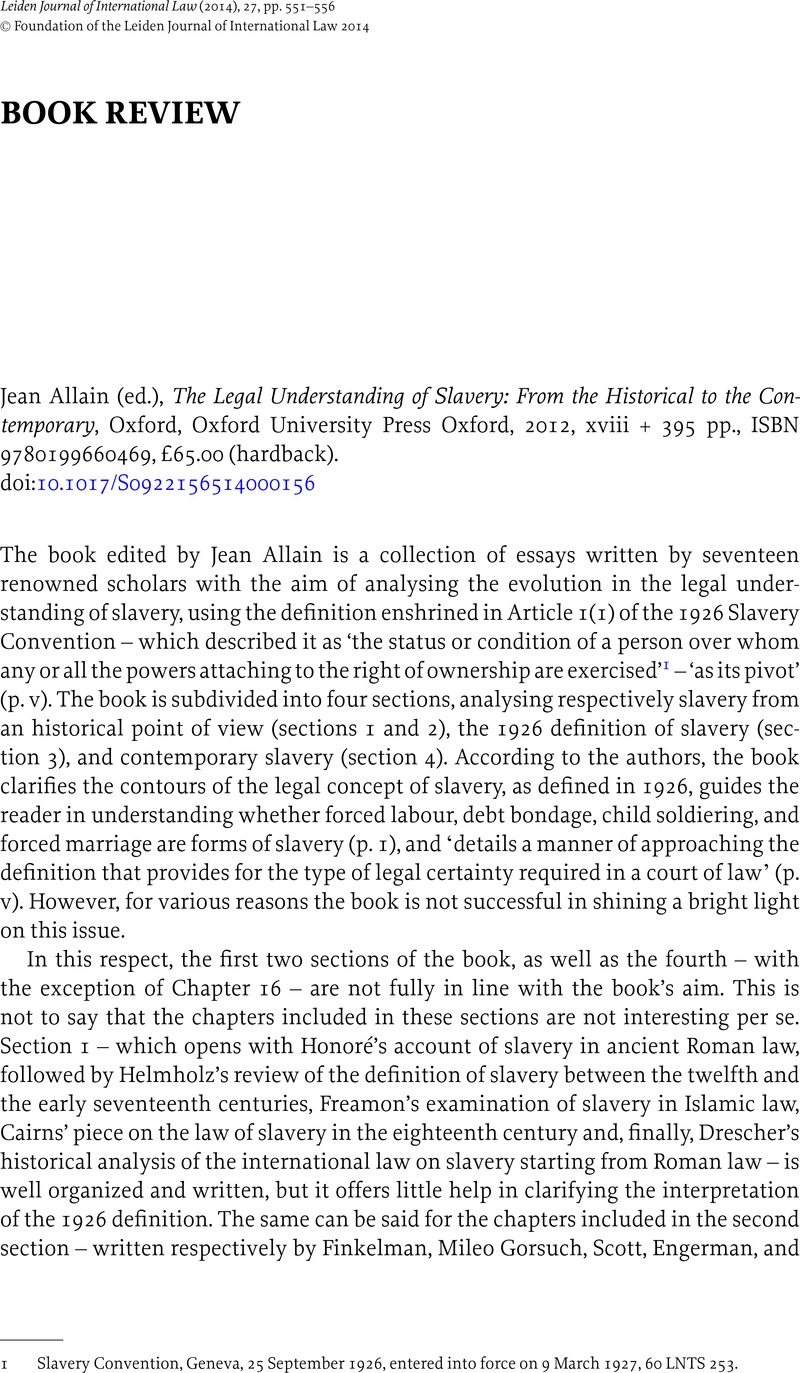Article contents
Jean Allain (ed.), The Legal Understanding of Slavery: From the Historical to the Contemporary, Oxford, Oxford University Press Oxford, 2012, xviii + 395 pp., ISBN 9780199660469, £65.00 (hardback).
Published online by Cambridge University Press: 24 April 2014
Abstract

- Type
- BOOK REVIEW
- Information
- Copyright
- Copyright © Foundation of the Leiden Journal of International Law 2014
References
1 Slavery Convention, Geneva, 25 September 1926, entered into force on 9 March 1927, 60 LNTS 253.
2 O. Patterson, Slavery as Social Death: A Comparative Study (1982), 21.
3 K. Bales, Disposable People: New Slavery in the Global Economy (2012), 8. It is interesting to note that this estimate is used as the title of a recent song by Matt Redman that, notwithstanding the good intention of raising the awareness of the phenomenon among the young generation – which is to be applauded – portrays the phenomenon of slavery today in a stereotyped way by focusing only on the sexual exploitation of women.
4 Supplementary Convention on the Abolition of Slavery, the Slave Trade and Institutions and Practices Similar to Slavery, Geneva, 7 September 1956, entered into force on 30 April 1957, 266 UNTS 3. Art.1(d) includes: ʻAny institution or practice whereby a child or young person under the age of 18 years, is delivered by either or both of his natural parents or by his guardian to another person, whether for reward or not, with a view to the exploitation of the child or young person or of his labourʼ.
5 Scarpa, S., ‘Benjamin N. Lawrence and Richard L. Roberts, eds. Trafficking in Slavery's Wake: Law and Experience of Women and Children in Africa. Athens, OH: Ohio University Press, 2012. ix + 271 pp. ISBN 978-0-8214-2002-7, $32.95 (paper)’ Enterprise and Society (2013) 1; doi: 10.1093/es/kht066Google Scholar.
6 The “white slave traffic” conventions are: the 1904 International Agreement for the Suppression of the White Slave Traffic – amended by a Protocol in 1948 – the 1910 International Convention for the Suppression of the White Slave Traffic, the 1921 International Convention for the Suppression of the Traffic in Women and Children, the 1933 International Convention for the Suppression of the Traffic in Women of Full Age and the 1949 Convention for the Suppression of the Traffic in Persons and the Exploitation of the Prostitution of Others.
7 Convention on the Rights of the Child, New York, 20 November 1989, entered into force on 2 September 1990, 1577 UNTS 3.
8 S. Detrick, A Commentary on the United Nations Convention on the Rights of the Child (1999), at 598–9.
9 Art. 1(c) makes reference to: ʻ(c) Any institution or practice whereby: (i) A woman, without the right to refuse, is promised or given in marriage on payment of a consideration in money or in kind to her parents, guardian, family or any other person or group; or (ii) The husband of a woman, his family, or his clan, has the right to transfer her to another person for value received or otherwise; or (iii) A woman on the death of her husband is liable to be inherited by another personʼ.
10 39 UNTS 55.
11 International Labour Organization, Combating Forced Labour: A Handbook For Employers and Business (2008), 8.
12 See, e.g., Art. 600 of the Italian Penal Code.
13 See, e.g., Art. 390(1) of the Criminal Code of Serbia.
- 2
- Cited by




